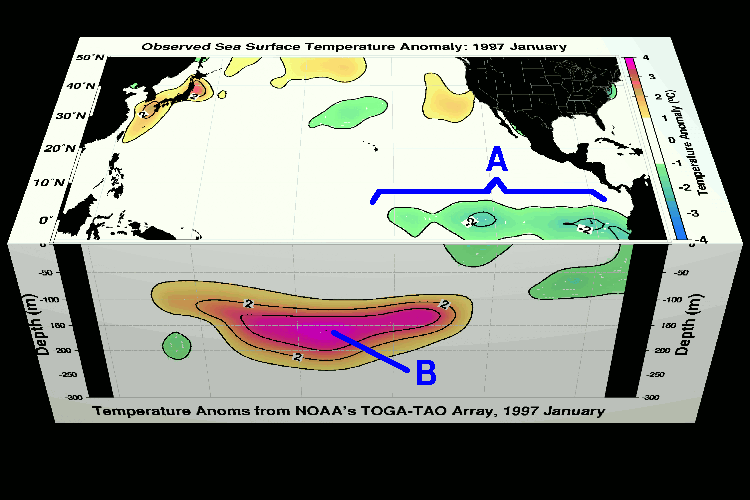


You're looking at a "three-dimensional" picture of temperature anomalies in the ocean. A temperature anomaly shows how the temperature is different from normal at that time of year; yellows and reds mean warmer than usual, greens and blues mean colder than usual. The top half of the picture shows what's happening on the surface of the ocean. You can see North America (and the United States) in the upper right, and Japan and parts of Asia in the upper left. The bottom half shows what's happening beneath the ocean, to a depth of about 300 meters (a bit less than 1000 feet). This is really only the topmost little bit of the ocean; the ocean is generally is 3,000 meters or more deep in the middle of the ocean, but for an El Nino, most of the action happens in the top few hundred meters. I've plotted things in this "three-dimensional" way so you can see, at the same time, how what happens at the ocean's surface is related to what happens beneath.
In January of 1997, the ocean was colder than usual off the coast of Peru (indicated by the blue/green colors marked "A" on the picture). But an El Nino is when he ocean is warmer than usual off the coast of Peru. So, you can see that the year started out with surface temperatures exactly opposite what you get with an El Nino.
Here's the interesting part. Look at the water marked "B" on the picture. That's water about 3 degrees Celsius (5 degrees F) warmer than usual, at about 150 meters depth, spread across the western half of the Pacific. In the past, many El Ninos have started out as just like this, with warm anomalies a couple hundred meters deep in the western Pacific.
At this time -- January, 1997 -- our prediction model had been forecasting for over a month that an El Nino would happen in the latter half of 1997. So, despite the cold surface temperatures off Peru ("A"), the warm water at depth ("B") was consistent with an upcoming El Nino.
Last modified: 10 October 1997
Contact: dpierce@ucsd.edu
Copyright © 2000 David W. Pierce. All rights reserved.